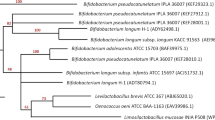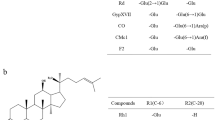Abstract
The thermostable GH3 family β-glucosidase DthBgl3 and thermostable GH78 family α-l-rhamnosidase DthRha from Dictyoglomus thermophilum DSM3960 were successfully immobilized by industrial amino resin 1000NH. The optimal reaction temperature and pH of 1000NH-DthBgl3 was 85 °C and pH 5.0. Over 65% residual enzyme activity maintained for 1000NH-DthBgl3 after a 3-h incubation under 85 °C, while about 20% residual enzyme activity maintained for free DthBgl3. The optimal reaction temperature and pH of 1000NH-DthRha was 95 °C and pH 6.5. Over 90% residual enzyme activity maintained for 1000NH-DthRha after a 3-h incubation under 90 °C, while about 22% residual enzyme activity maintained for free DthRha. Meanwhile, immobilized 1000NH-DthBgl3 and 1000NH-DthRha were successfully and could completely transform all major ingredient of 10 g/L total flavonoids extract from Epimedium (TFEE) into icaritin. After 15 cycles (45 h) of repeated use at 85 °C, 3 U 1000NH-DthBgl3 showed a molar conversion rate of 73.12%, initial activity of 30.09% and productivity of 124 mg/L/h, while 15 U 1000NH-DthRha showed a molar conversion rate of 88.50%, initial activity of 85.31% and productivity of 75 mg/L/h after ten cycles (60 h) of repeated use at 85 °C. The cooperation of two immobilized enzymes showed a molar conversion rate of 87.21% and productivity of 141 mg/L/h after 15 cycles of repeated use at 85 °C. This is the first report on immobilization of two thermostable glycosidases from thermophilic bacteria and their cooperated biocatalysis of all major ingredients of TFEE into icaritin with high productivity under a high substrate concentration.
Graphical Abstract









Similar content being viewed by others
References
Ma H, He X, Yang Y, Li M, Hao D, Jia Z (2011) The genus Epimedium: an ethnopharmacological and phytochemical review. J Ethnopharmacol 134(3):519–541
Tong JS, Zhang QH, Huang X, Fu XQ, Qi ST, Wang YP et al (2011) Icaritin causes sustained ERK1/2 activation and induces apoptosis in human endometrial cancer cells. PLoS ONE 6(3):e16781
Li C, Peng W, Song X, Wang Q, Wang W (2016) Anticancer effect of icaritin inhibits cell growth of colon cancer through reactive oxygen species, Bcl-2 and cyclin D1/E signaling. Oncol Lett 12(5):3537
Zhang W, Xing B, Yang L, Shi J, Zhou X (2015) Icaritin attenuates myocardial ischemia and reperfusion injury via anti-inflammatory and anti-oxidative stress effects in rats. Am J Chin Med 43(06):1–15
Zhang G, Qin L, Sheng H, Wang X, Wang Y, Yeung DK et al (2009) A novel semisynthesized small molecule icaritin reduces incidence of steroid-associated osteonecrosis with inhibition of both thrombosis and lipid-deposition in a dose-dependent manner. Bone 44(2):345–356
Jing L, Peng L, Ruixiu Z, Lu C, Haihua Q, Jian L et al (2011) Icaritin induces cell death in activated hepatic stellate cells through mitochondrial activated apoptosis and ameliorates the development of liver fibrosis in rats. J Ethnopharmacol 137(1):714–723
Chen X, Song L, Hou Y, Li F (2019) Reactive oxygen species induced by icaritin promote DNA strand breaks and apoptosis in human cervical cancer cells. Oncol Rep 41(2):765–778
Guo Y, Zhang X, Meng J, Wang Z (2011) An anticancer agent icaritin induces sustained activation of the extracellular signal-regulated kinase (ERK) pathway and inhibits growth of breast cancer cells. Eur J Pharmacol 658(2–3):114–122
Wang S, Wang Q, Wang H, Qin C, Cui X, Li L et al (2019) Induction of ROS and DNA damage-dependent senescence by icaritin contributes to its antitumor activity in hepatocellular carcinoma cells. Pharm Biol 57(1):424–431
Dell Agli M, Galli GV, Dal Cero E, Belluti F, Matera R, Zironi E et al (2008) Potent inhibition of human phosphodiesterase-5 by icariin derivatives. J Nat Prod 71(9):1513–1517
Nguyen V, Shi L, Li Y, Wang Q (2014) Total synthesis of icaritin via microwave-assistance claisen rearrangement. Lett Org Chem 11:677–681
Tong J, Liu C, Wang B (2019) Improved synthesis of icaritin and total synthesis of β-anhydroicaritin. Chem Res Chin U 35(4):616–620
Angeloni C, Barbalace MC, Hrelia S (2019) Icariin and its metabolites as potential protective phytochemicals against Alzheimer’s disease. Front Pharmacol 10:271
Zhou J, Chen Y, Wang Y, Gao X, Qu D, Liu CA (2014) Comparative study on the metabolism of Epimedium koreanum nakai-prenylated flavonoids in rats by an intestinal enzyme (lactase phlorizin hydrolase) and intestinal flora. Molecules 19(1):177–203
Pei L, Sun S, Guo B, Huang W, Xiao P (2008) Fast quality control of Herba Epimedii by using Fourier transform infrared spectroscopy. Spectrochim Acta A 70(2):258–264
Zhang H, Yang T, Li Z, Wang Y (2008) Simultaneous extraction of epimedin A, B, C and icariin from Herba Epimedii by ultrasonic technique. Ultrason Sonochem 15(4):376–385
Jin X, Zhang Z, Sun E, Li S, Jia X (2012) Statistically designed enzymatic hydrolysis of an icariin/β-cyclodextrin inclusion complex optimized for production of icaritin. Acta Pharm Sin B 2(1):83–89
Tao Z, Liu J, Jiang Y, Gong L, Yang B (2017) Synthesis of prenylated flavonols and their potents as estrogen receptor modulator. Sci Rep. https://doi.org/10.1038/s41598-017-12640-9
Lin C, Wu Z, Tang X, Hao C, Zheng R, Zheng Y (2019) Continuous production of aprepitant chiral intermediate by immobilized amidase in a packed bed bioreactor. Bioresour Technol 274:371–378
Shen J, Qi J, Zhang X, Liu Z, Zheng Y (2019) Efficient Resolution of cis-(±)-dimethyl 1-acetylpiperidine-2,3-dicarboxylate by covalently immobilized mutant Candida antarctica lipase b in batch and semicontinuous modes. Org Process Res Dev 23(5):1017–1025
Sun J, Chen Y, Sheng J, Sun M (2015) Immobilization of Yarrowia lipolytica lipase on macroporous resin using different methods: characterization of the biocatalysts in hydrolysis reaction. Biomed Res Int 2015:1–7
Albino Gomes A, Pazinatto Telli E, Miletti LC, Skoronski E, Gomes Ghislandi M, Felippe Da Silva G et al (2018) Improved enzymatic performance of graphene-immobilized β-glucosidase A in the presence of glucose-6-phosphate. Biotechnol Appl Biochem 65(2):246–254
Liu A, Huang B, Lei L, Lu YJ, Zhou JL, Wong WL (2019) Production of high antioxidant activity flavonoid monoglucosides from citrus flavanone with immobilised α-l-rhamnosidase in one step. Int J Food Sci Technol 54(10):2854–2862
Synowiecki J, Wołosowska S (2006) Immobilization of thermostable β-glucosidase from Sulfolobus shibatae by cross-linking with transglutaminase. Enzyme Microb Technol 39(7):1417–1422
Mateo C, Palomo JM, Fernandez-Lorente G, Guisan JM, Fernandez-Lafuente R (2007) Improvement of enzyme activity, stability and selectivity via immobilization techniques. Enzyme Microb Technol 40(6):1451–1463
Magner E (2013) Immobilisation of enzymes on mesoporous silicate materials. Chem Soc Rev 42(15):6213–6222
Sheldon RA (2007) Enzyme immobilization: the quest for optimum performance. Adv Synth Catal 349(8–9):1289–1307
Li Q, Wu T, Zhao L, Pei J, Wang Z, Xiao W (2019) Highly efficient biotransformation of astragaloside IV to cycloastragenol by sugar-stimulated β-glucosidase and β-xylosidase from Dictyoglomus thermophilum. J Microbiol Biotechnol 29(12):1882–1893
Barbosa O, Ortiz C, Berenguer-Murcia Á, Torres R, Rodrigues RC, Fernandez-Lafuente R (2015) Strategies for the one-step immobilization–purification of enzymes as industrial biocatalysts. Biotechnol Adv 33(5):435–456
Zhang X, Shi P, Deng H, Wang X, Liu Z, Zheng Y (2018) Biosynthesis of chiral epichlorohydrin using an immobilized halohydrin dehalogenase in aqueous and non-aqueous phase. Bioresour Technol 263:483–490
Cavalcanti EDC, Aguieiras ÉCG, Da Silva PR, Duarte JG, Cipolatti EP, Fernandez-Lafuente R et al (2018) Improved production of biolubricants from soybean oil and different polyols via esterification reaction catalyzed by immobilized lipase from Candida rugosa. Fuel 215:705–713
Rios NS, Pinheiro MP, Dos Santos JCS, de Fonseca T, Lima LD, de Mattos MC et al (2016) Strategies of covalent immobilization of a recombinant Candida antarctica lipase B on pore-expanded SBA-15 and its application in the kinetic resolution of (R, S)-phenylethyl acetate. J Mol Catal B 133:246–258
Silva JA, Macedo GP, Rodrigues DS, Giordano RLC, Gonçalves LRB (2012) Immobilization of Candida antarctica lipase B by covalent attachment on chitosan-based hydrogels using different support activation strategies. Biochem Eng J 60:16–24
Pahujani S, Kanwar SS, Chauhan G, Gupta R (2008) Glutaraldehyde activation of polymer nylon-6 for lipase immobilization: enzyme characteristics and stability. Bioresour Technol 99(7):2566–2570
Sannino F, Costantini A, Ruffo F, Aronne A, Venezia V, Califano V (2020) Covalent immobilization of β-glucosidase into mesoporous silica nanoparticles from anhydrous acetone enhances its catalytic performance. Nanomater Basel 10(1):108
Venezia V, Sannino F, Costantini A, Silvestri B, Cimino S, Califano V (2020) Mesoporous silica nanoparticles for β-glucosidase immobilization by templating with a green material: tannic acid. Micropor Mesopor Mater 302:110203
Figueira JA, Sato HH, Fernandes P (2013) Establishing the feasibility of using β-glucosidase entrapped in lentikats and in sol-gel supports for cellobiose hydrolysis. J Agric Food Chem 61(3):626–634
Verma ML, Rajkhowa R, Wang X, Barrow CJ, Puri M (2013) Exploring novel ultrafine Eri silk bioscaffold for enzyme stabilisation in cellobiose hydrolysis. Bioresour Technol 145:302–306
Zou SP, Gu K, Zheng YG (2018) Covalent immobilization of halohydrin dehalogenase for efficient synthesis of epichlorohydrin in an integrated bioreactor. Biotechnol Progr 34(3):784–792
Singh V, Rakshit K, Rathee S, Angmo S, Kaushal S, Garg P et al (2016) Metallic/bimetallic magnetic nanoparticle functionalization for immobilization of α-amylase for enhanced reusability in bio-catalytic processes. Bioresour Technol 214:528–533
Brady D, Jordaan J (2009) Advances in enzyme immobilisation. Biotechnol Lett 31(11):1639–1650
Yadav V, Yadav PK, Yadav S, Yadav KDS (2010) α-l-Rhamnosidase: a review. Process Biochem 45(8):1226–1235
Liese A, Hilterhaus L (2013) Evaluation of immobilized enzymes for industrial applications. Chem Soc Rev 42(15):6236–6249
Acknowledgements
This work was supported by the National Natural Science Foundation of China (21978135), the National Key R & D Program of China (2016YFD0600805), and the Jiangsu “333” project of cultivation of high-level talents (BRA2015317).
Author information
Authors and Affiliations
Contributions
Conceived and designed the experiments: LZ, SZ, YD. Performed the experiments: SZ, YD, CL. Analyzed the data: YD, SZ, CL, JX. Contributed reagents/materials/analysis tools: YD, LZ, JX. Wrote the manuscript: YD, SZ, LZ, JP. Revised and approved the final version of the paper: LZ.
Corresponding author
Ethics declarations
Conflicts of Interest
None of authors have any conflict of interest to report.
Additional information
Publisher's Note
Springer Nature remains neutral with regard to jurisdictional claims in published maps and institutional affiliations.
Rights and permissions
About this article
Cite this article
Dong, Y., Zhang, S., Lu, C. et al. Immobilization of Thermostable β-Glucosidase and α-l-Rhamnosidase from Dictyoglomus thermophilum DSM3960 and Their Cooperated Biotransformation of Total Flavonoids Extract from Epimedium into Icaritin. Catal Lett 151, 2950–2963 (2021). https://doi.org/10.1007/s10562-020-03522-3
Received:
Accepted:
Published:
Issue Date:
DOI: https://doi.org/10.1007/s10562-020-03522-3




